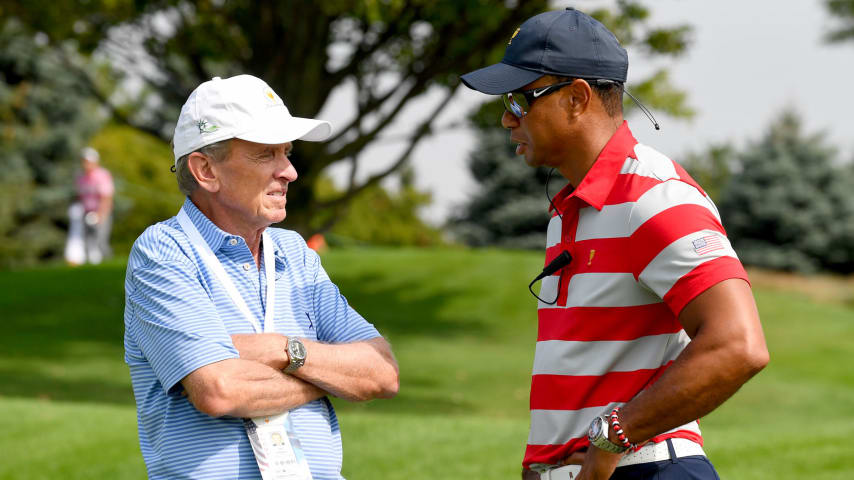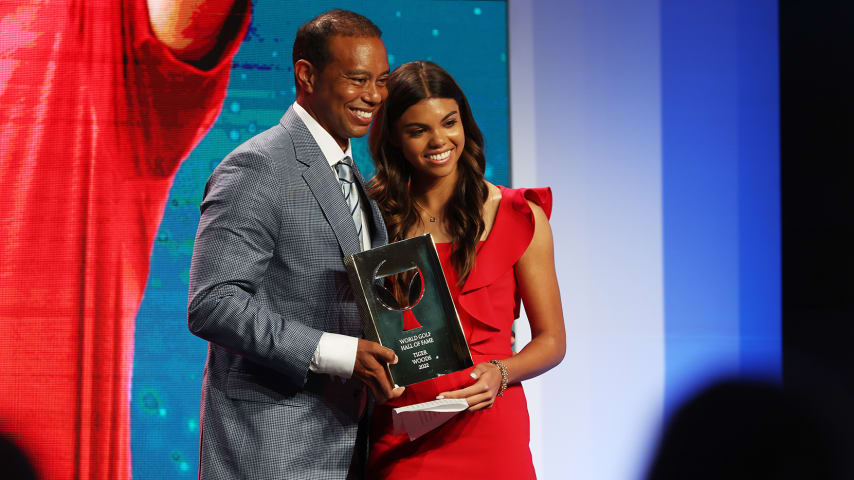Tiger Woods, Tim Finchem enter World Golf Hall of Fame together after parallel careers
8 Min Read

Written by Jim McCabe
There is a story that former PGA TOUR Commissioner Tim Finchem is fond of telling whenever he is asked about the incomparable career of Tiger Woods.
It was the Saturday night before the final round of the 1997 Masters and with Woods leading by nine shots, the conversation between Finchem and his wife, Holly, and their dinner companions, Phil Knight and wife Penny, was understandably light and breezy. But at one point, the co-founder and CEO of Nike looked at Finchem and said, “Tim, you and I have one thing in common: All we have to do is ride the wave.”
“The wave,” a.k.a. Woods, would win that Masters by a whopping 12 strokes and continue to take the PGA TOUR by storm. (At that point he had won four of his 15 starts, dating back to his pro debut in August of ’96.) Knight’s inference was clear: His company’s investment in Woods was looking majestic and so, too, did the PGA TOUR appear to be in good shape with the then 21-year-old phenom just getting going.
Finchem loves that story and nearly 25 years later it still makes him chuckle.
Some of his closest friends and confidants are not as enamored with the remembrance, however. They feel it plays into a line of thinking that they regard as careless – that is, that Finchem’s legacy as PGA TOUR Commissioner (1994-2016) is owed to the fortuitous arrival of Woods as a pro in 1996.
But if these friends and confidants don’t often succeed in getting Finchem to ignore that story and take a little more credit for the massive growth of the PGA TOUR, it doesn’t surprise three-time PGA TOUR winner Olin Browne.
“Tim had no interest in being the center of attention,” said Browne, who served as a member of the Player Advisory Council and thus studied Finchem in a business setting. “Tim was the perfect guy to lead the TOUR. He had a Rolodex that was very real and he had had life experiences (as a member of President Jimmy Carter’s administration) that counted. But he cared very little for being the center of attention.”
Come March 9, however, Finchem will be unable to avoid being the center of attention. That’s because the World Golf Hall of Fame has come calling and Finchem, 74, will be inducted. Fittingly, Finchem will share the induction spotlight with Woods, 46, and the way Browne sees it, that is having the planets aligned.
“They will always be linked,” he said, “and there was an incredible symbiosis with them.”
Browne’s assessment is on target as the parallel PGA TOUR careers of Finchem and Woods are a study in historic achievements and sport-altering impacts.
Finchem was named Commissioner in May 1994, succeeding Deane Beman. Just three months later, Woods won the first of his three consecutive U.S. Amateur titles in the shadows of PGA TOUR headquarters. Woods’ victory over Trip Kuehne in the final match at TPC Sawgrass was punctuated by a birdie on the TOUR’s trademark hole – the island-green 17th – that was followed by the sort of fist pump that Woods would make famous in the years to come. It gave Finchem a sense of what this young phenom might mean to the PGA TOUR.
“I was in Akron (Ohio) for the World Series of Golf and when I went in the locker room, all the TOUR players were sitting around and they’re watching Tiger Woods play in the Amateur,” Finchem recalled. “I’ve never seen TOUR players that interested in watching any other golfer.”
Two years later, Woods would make his pro debut on the PGA TOUR and to say he and Finchem “rode a wave” the next 22 years would be an understatement of massive proportions.
“Bit of an odd couple, given how old-school and reserved Tim is,” laughs Seth Waugh, the current CEO of the PGA of America who in a previous executive role with Deutsche Bank of Americas negotiated a tournament deal with Finchem, as well as a charitable component to the Deutsche Bank Championship that involved Woods’ foundation.
He knows them both well and marvels at how they coexisted seamlessly.
“They mutually benefited greatly from the other’s skills – Tiger the transcendent talent and force of nature, Tim understanding the value of that and cleverly leveraging it to the benefit of all. Tiger was clearly the most underpaid athlete on the planet, but he was OK with it, because of his respect for the game and its history.”
Woods’ achievements, of course, are etched in the record books and significantly documented, but during the Finchem regime here are the highlights:
• Seventy-nine of his 82 career wins (which is tied with Sam Snead for most ever).
• Fourteen of the 15 major championships that has him second to only Jack Nicklaus.
• An unprecedented “Tiger Slam” – four major triumphs in a row in 2000-01.
• Three Career Grand Slams to match something that only Nicklaus has done.
• Ten times, he won five or more tournaments in a season.
• Ten times, he was PGA TOUR Player of the Year.
• Two more wins at TPC Sawgrass, making him the only man to win THE PLAYERS in both March and May.
• Victories in two of the first three editions of the FedExCup.
• PGA TOUR wins in seven countries.
• The bulk of his record $120m in career earnings came in the 1996-2016 period.
Awe-inspiring stuff, immortal feats, for sure, and Woods’ entrance into the World Golf Hall of Fame was never in doubt.
But there is a symmetry to the 22-year stretch that should not be overlooked, when Woods and Finchem combined to massively grow the PGA TOUR. Finchem’s handprints are all over significant developments during this time, even if they don’t receive the sort of accolades that Woods’ numbers do:
• When he became Commissioner, there were three tours and total purses of $90 million. By 2016, there were six tours and $328 million in pursues.
•The World Golf Championships were introduced in 1999. Woods would win 16 of the first 33.
• In 2016, golf returned to the Olympics for the first time in more than 100 years.
• The FedExCup, a season-long competition that culminated with a sequence of Playoff events, began in 2007.
• First Tee was born in 1997 and it remains a pet project of Finchem’s. More than three million youngsters are impacted annually.
• Most eye-opening is the charitable component that the PGA TOUR donates to local communities. From the first check in 1937, it reached $1 billion in 2005, then needed just nine years to surpass $2 billion. (In 2020 it reached $3 billion. “Three billion,” said Browne. “That’s shocking. That’s real.”)
Toss it all around, digest all of it, and Brad Faxon concedes it is fascinating how each man contributed so much during such a joint time frame. Faxon, who was in his 12th year on TOUR when Finchem succeeded Beman, served several stints on the PAC under Finchem’s watch and heard a lot of people say that “it was good luck” that Woods came along when he did.
“Luck equals opportunity plus preparedness and Tim was always prepared,” said Faxon. “Bottom line is, it’s fitting they enter the Hall of Fame in the same class.”
What strikes Browne are the contributions each inductee made to the incredible growth of the pro game.
“Tiger attracted the eyes and ears of the sports world to what was always a pooh-poohed sport,” he said. “He legitimized golf as an athletic endeavor. And Tim, to his credit, understood the value that golf brought and that there was a confluence to Tiger – a social aspect, he was telegenic to the ‘Nth’ power, he was made for the moment.”
Finchem is on record as calling Woods “the most recognizable athlete on the planet” and that “he changed the landscape and effected TV (viewership and contracts), sponsorships and took golf to a whole new level.”
Browne wouldn’t dispute any of that. He also agrees that it shouldn’t go unnoticed that for all the might each of them wielded, rarely were they not on the same page.
“I just don’t think that either one of them tried to pull anything over on the other,” said Browne. “I think Tiger knew that his relevance in history was through the PGA TOUR, that he understands that the value of his legacy is built around the records he attains.
“Tim’s relevance was to try and grow the game and he knew how to do it. If something needed to be done, he picked up the phone and would get a response.”
Taken as individuals, the game was lucky to have them. Taken in tandem, the game saw growth no one could have envisioned. Browne suggests avoiding the chicken-or-egg discussion when it comes to these two men.
“When it comes to assignation, who gets the credit, or who did what, I don’t think either one cares,” he said. “Tiger Woods wanted to be the greatest player. Tim wanted to grow the game. Both did that … and they left the game better than it was when they came into it. That’s the definition of greatness. That’s why they deserve everything they get. It’s why they’re going into the Hall of Fame.”
Together. As it should be.





